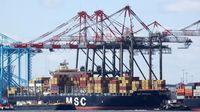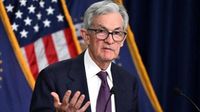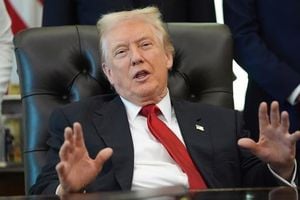Wholesale prices in the United States have surged at a pace not seen in years, sending ripples through markets and raising pointed questions about the role of tariffs, weather, and labor policies in fueling inflation. Recent government data released in mid-August 2025 revealed a staggering 38% spike in the wholesale price of vegetables for July—the sharpest increase for any product category—while the broader Producer Price Index (PPI) rose 0.9% month-over-month and 3.3% year-over-year, both well above economists’ expectations.
These developments have set off alarms among economists, business leaders, and policymakers. While some analysts are quick to point to the Trump administration’s tariffs as a primary culprit, others caution that the story is more complicated, involving a mix of trade policy, supply chain disruptions, labor shortages, and even the weather.
According to ABC News, the U.S. imports more than a third of its fresh vegetables, making the sector especially vulnerable to trade policy shocks. Unlike retailers of durable goods who can stockpile inventory ahead of tariff hikes, importers of perishable foods like vegetables have no such luxury—produce simply won’t keep. “This could be the impact of tariffs,” David Ortega, a food economist at Michigan State University, told ABC News. “But it could be a whole host of things.”
Indeed, the spike in wholesale vegetable prices has not yet filtered down to consumers. Government data shows that prices faced by shoppers remained unchanged from June to July, and over the past year, vegetable prices have risen a mere 0.2%—well below the overall inflation rate of 2.7%. But experts warn that if wholesale prices remain elevated for several months, consumers could soon feel the pinch at the checkout line. Parke Wilde, a food economist at Tufts University, explained, “If the current rise in wholesale vegetable prices were to carry over for a few months, then shoppers would begin to notice higher prices. Consumer price hikes under such a scenario could exceed 10%. For now, we don't know. It's something to monitor.”
Other sectors are also feeling the heat. The Department of Labor’s report, covered by Reason.com, showed a 1.4% jump in wholesale food prices and a more than 3% rise in consumer electronics. The PPI, which tracks prices paid to domestic producers, is considered an advance warning system for consumer inflation, as wholesale cost increases are often passed along to shoppers. “If it were true that the higher costs of tariffs were paid entirely by foreign producers or that American companies were eating the cost of the tariffs—two claims the Trump administration has repeatedly made—then you would not expect to see any tariff-related impact on the PPI,” Reason.com noted. But the data suggest otherwise, with economists warning that tariffs on imported raw materials and components are raising costs for American producers.
Goldman Sachs economists, as cited by The New York Post, estimate that consumers could soon bear up to 67% of tariff costs, up dramatically from 22%, thereby escalating broader inflation risks. This shift means that the burden of tariffs, initially absorbed by companies, is increasingly being passed on to consumers—potentially hitting household budgets just as the broader economy faces other headwinds.
Sweetgreen, a popular restaurant chain known for its salads and grain bowls, reported a 3.6 percentage-point decline in restaurant-level profit over the three months ending in June 2025 compared to the previous year, attributing part of the loss to tariffs. The company’s experience is emblematic of a larger trend: as input costs rise, businesses face tough choices about whether to absorb the hit, raise prices, or cut costs elsewhere.
Complicating matters further are the Trump administration’s restrictive immigration policies, which have contributed to labor shortages in agriculture. With roughly two-thirds of agricultural workers identifying as non-citizen immigrants, according to a KFF analysis of a U.S. Labor Department survey, the detention of undocumented immigrants and the revocation of Temporary Protected Status have squeezed the labor supply. “There have been a lot of immigration raids across the country. Those could be impacting workers wanting to go into the field to harvest. And that could drive labor costs up and increase the prices of these items,” Ortega told ABC News.
Despite these pressures, President Trump has remained defiant. In a social media post on August 12, 2025, he insisted, “Tariffs have not caused Inflation, or any other problems for America, other than massive amounts of CASH pouring into our Treasury's coffers. Also, it has been shown that, for the most part, Consumers aren't even paying these Tariffs, it is mostly Companies and Governments, many of them Foreign, picking up the tabs.”
Yet, markets are not so sanguine. The hotter-than-expected PPI report has forced investors to rethink the likelihood of a Federal Reserve interest rate cut in September. Before the data release, futures traders had nearly priced in a 0.50% rate cut, but that probability has since plummeted, with the chance of even a modest 0.25% cut dropping to 91.8%, according to the CRE Group FedWatch Tool. “Today’s PPI surge is unwelcome given last week’s jobs figures,” Ken Mahoney, CEO of Mahoney Asset Management, told The New York Post. “It may be a one-off, but markets will watch if that trend persists.”
Federal Reserve officials have expressed growing concern about the dual challenge of rising inflation and a cooling labor market. Alberto Musalem, president of the St. Louis Fed, noted that services represented 80% of the inflation increases in both the PPI and the Consumer Price Index. Chicago Fed President Austan Goolsbee warned of a potential stagflation threat from tariffs, saying, “It makes both sides of the mandate go bad at the same time...there’s not an obvious answer.”
Looking ahead to the Fed’s September 16-17 meeting, several data points will shape the central bank’s decision-making: retail sales figures, Jackson Hole speeches, further labor market data, and any new tariff developments. The labor market, for its part, offers mixed signals. Continuing jobless claims have dipped, and initial claims stand at about 224,000, but the overall trend hints at a gradual cooling compared to earlier in the year.
Meanwhile, external factors like adverse weather have also played a role. Droughts in major coffee-producing countries such as Brazil and Vietnam have pushed up prices for coffee, another example of how global disruptions can ripple through U.S. markets. As with vegetables, analysts warn that tariffs could exacerbate these price increases, compounding the inflationary pressures already in play.
In sum, the surge in wholesale prices reflects a complex interplay of tariffs, labor shortages, supply chain challenges, and even the weather. While consumer prices have so far remained relatively stable, the warning lights are flashing. If current trends persist, Americans may soon find their grocery bills and restaurant tabs climbing higher—whether they’re buying salad greens or a cup of coffee.





